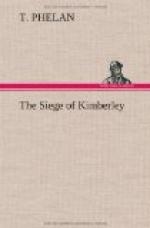But the interregnum was of brief duration, for, to our unspeakable horror, the bombardment was resumed at nine o’clock. If in the clear light of day the shells were trying, what were they in the night! A ghost story well told in the daytime perturbs a superstitious mind; but to feel queer at its recital in the night one need not necessarily be superstitious at all. This new departure intensified the strain and went far to make faint many a heart that had until then remained stout. The guns were fired with longer intervals between the shots; the shells did not follow on the top of one another as in the day; but one nocturnal projectile excited as much terror as did ten when the sun was shining. Far into the night—for hours after midnight—the war was waged, and sleep denied the pleasure of steeping our “senses in forgetfulness.” To sleep was nearly impossible, and at the first peep of dawn to recline on a bed at all was not easy, so fierce and sudden was the energy with which a dozen guns commenced to bark in chorus.
And with sad results. The men in the redoubts enjoyed comparative immunity from the dangers of the bombardment; it was mainly the women and children in the houses who had to bear the brunt of the assaults. A lamentable instance of the pity of it was only too soon forthcoming. In the house of a Mr. Webster (who was in camp with his regiment, the Volunteers) his wife and children were at breakfast, when crash! through the roof came a shell on top of the tea-pot. The mother sustained fearful injuries, to which she subsequently succumbed. Her six-year-old child was also killed; her second son had his leg and arm broken; while her youngest child—a little girl—was badly bruised. The stricken family were removed to hospital amid a shower of shells, which continued with unabashed fury to seek whom they slaughter. Nearly all our public buildings were hit, and the places of worship were again a mark for the vandal. Houses everywhere were damaged, and extraordinary indeed were the escapes of their distracted occupiers. No less gracious was the kindly fortune that shielded those whom duty, caprice, or foolhardiness brought into the streets. One family stuffed away in the ostensible security of a coal-hole vegetated there all day. They were grateful for their modern ark, but outraged nature disapproved and caused a shell to pierce it. Nobody was hurt, remarkable to relate, and the frightened household ascended with alacrity to take their chances in a purer atmosphere. In every part of the town the shells kept falling. Beaconsfield appeared to be the most favoured hunting ground, for its Sanatorium was not only a colossal structure but the home of the Colossus himself. Hundreds of shells dropped in its vicinity, while the millionaire went round the city in a cart, to all outward seeming as little concerned as the most penurious of men. Some weeks before a grazier who had fallen into the hands of the Boers had been assured that it was Rhodes they wanted—not Kimberley. Such a revelation in the case of a personality less notable or less esteemed might have made things awkward for him.




